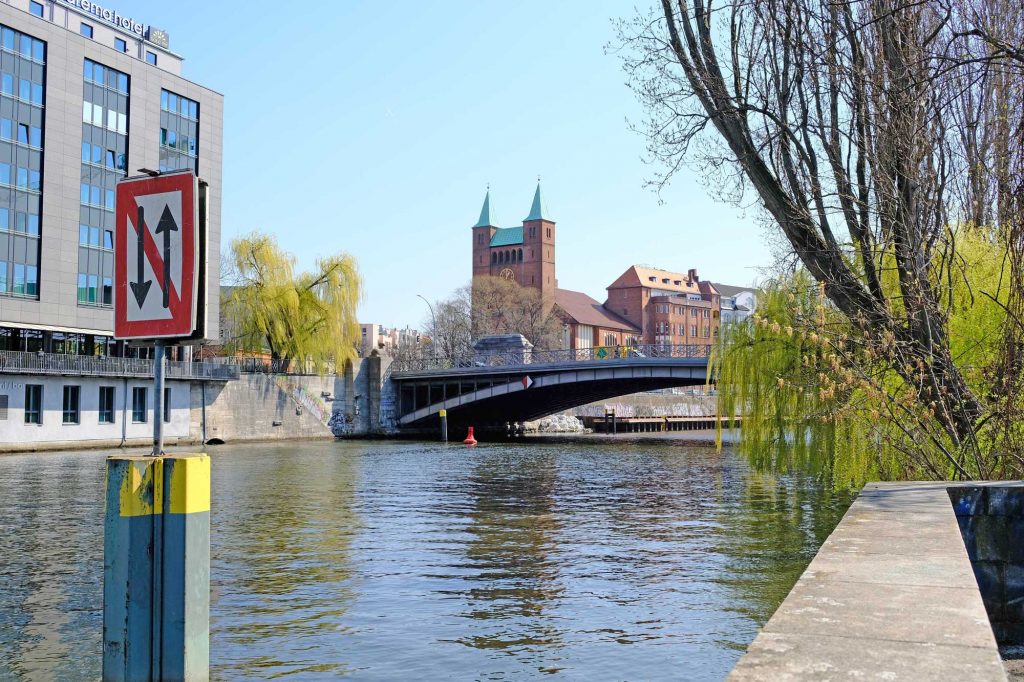Who lives and works, believes and engages everything in the neighborhood? Visiting the Church of the Redeemer.
Hard and short is the chime of bells that rings over the Spree. Just behind the bend in the river, just quickly over the bridge, at the corner, there is the Erlöserkirche. It looks a bit gloomy from outside. The clumsy double towers scratch at the clouds. More like a fortress than a church, that is how it looks. But inside, life is waiting. Two priests open the heavy wooden door of a side entrance and ask to enter the rectory. At the same time, a group of children from the Protestant day care center runs down the stairs. The children are giggling and jumping up and down, they are on their way to the courtyard, there is a playground and some greenery. Singing sounds from one of the rooms on the first floor. In another one a woman is practicing trumpet. The community hall is filled to the last spot with chairs. Tonight the choir rehearses here. This is the church choir, about 60 men and women singing along.
“Her performances are known all over Berlin,” says Rebekka Weinmann with some pride in her voice. She is one of the pastors. 35 years old, she wears her blond hair short. She has just returned from a seminar where she learned how to write and deliver better sermons. She and her colleague Sascha Gebauer are the pastor-double team and are responsible for a total of four churches in this area.
These two have not been transferred here. No, they applied here. Why? “This is a lively and large community. There is a lot going on here. Many volunteers who do a lot,” says Sascha Gebauer. “At the same time, the community is very diverse with its four churches. We have people from the rather poor district of Moabit, from the richer Charlottenburg and even down to the Reichstag bank,” says Rebekka Weinmann.
You yourself cycle from church to church. You with a folding bike. He with a mountain bike. You hold the respective church services, meet people for conversations, marry wedding couples, bury the deceased and for the baptisms of the small children you ride home to the families on request. “This is more private, the families and the children feel more comfortable in their living room,” says Gebauer, who likes these visits because they allow him to get to know his parishioners in a different way.
Perhaps the Erlöserkirche also stands a bit for the Berlin districts that collide here. Moabit on one side, Charlottenburg on the other. If you walk up the street towards Moabit, you will pass many small and international shops until you stand in front of the famous Berlin criminal court. But if you cross the bridge to Charlottenburg, you will see university research facilities, chic factory floors with start-ups, car dealers, allotments, and solid apartment buildings.
“We pastors are something like the backbone of the congregation. The arms and legs are the congregation and the volunteers themselves,” says Sascha Gebauer. And the arms and legs lift a lot. There are the youth and children’s choirs, the confirmation group and the trips to Taize. There are organ services and jazz services with live bands. If you like it quieter, you can visit the meditative church service. Every Thursday about 100 people in need pick up food donations. Even the only liberal mosque in Germany with a woman as imam has found shelter in the church rooms.
And the church is growing, also because the region is changing. There is the district of Moabit, where more and more families and students are moving in, and there are several new building projects, like Charlottenbogen, which attract new residents. “We have about 100 new reports per month. We write to them, invite them and many come, too,” says Rebekka Weinmann.
Then the two lead through the now silent nave, not even the noise of cars from the street enters the high room. “But on Sundays almost all the rows here are occupied,” say the two priests.
Their community is alive and that is great fun for them.



